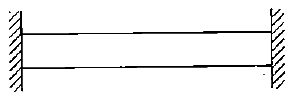Two rods of equal cross sections, one of copper and the other of steel, are joined to form a composite rod of length 2.0 m at 20∘C, the length of the copper rod is 0.5 m. When the temperature is raised to 120∘C, the length of composite rod increases to 2.002m. If the composite rod is fixed between two rigid walls and thus not allowed to expand, it is found that the lengths of the component rods also do not change with increase in temperature. Calculate Young's moulus of steel. (The coefficient of linear expansion of copper, αc=1.6×10−5∘C and Young's modulus of copper is 1.3×1013N/m2).

Δl=lSαSΔT+lcαcΔT
0.002=[1.5αS+0.5×1.6×10−5]×100
αs=1.2×10−51.5=8×10−6∘C
there is no change in component length
For steel,
x=lsαsΔT−FlSAYS=0
FAYS=αSΔT
For copper,
x=FlSAyc−lcαcΔT=0
FAyc=αΔT .(ii)
On dividing Eq. (i) by Eq. (ii), we get
ySyc=αcαS
yS=yc×αcαS=1.5×1013×1.6×10−58×10−6
yS=3×1013N/m2
Topper's Solved these Questions
- CALORIMETRYBOOK - CENGAGE PHYSICSCHAPTER - CALORIMETRYEXERCISE - Exercise 1.3
18 Videos
- CALORIMETRYBOOK - CENGAGE PHYSICSCHAPTER - CALORIMETRYEXERCISE - Subjective
25 Videos
- CALORIMETRYBOOK - CENGAGE PHYSICSCHAPTER - CALORIMETRYEXERCISE - Exercise 1.1
23 Videos
- BASIC MATHEMATICSBOOK - CENGAGE PHYSICSCHAPTER - BASIC MATHEMATICSEXERCISE - Exercise 2.6
20 Videos
- CENTRE OF MASSBOOK - CENGAGE PHYSICSCHAPTER - CENTRE OF MASSEXERCISE - INTEGER_TYPE
1 Video
Similar Questions
A composite rod is made by joining a copper rod, end to end, with a second rod of different material but of the same area of cross section. At 25∘C, the composite rod is 1m long and the copper rod is 30cm long. At 125∘C the length of the composte rod increases by 1.91mm. When the composite rod is prevented from expanding by bolding it between two rigid walls, it is found that the constituent reds have remained unchanged in length in splite of rise of temperature. Find yong's modulus and the coefficient of linear expansion of the second red (Y of copper =1.3×1010N/m2 and a of copper =17×10−6/K).
View SolutionA rod of length / and radius r is held between two rigid walls so that it is not allowed to expand. If its temperature is increased, then the force developed in it is proportional to
View Solution
Knowledge Check
Two rods of equal cross-sections, one of copper and the other of steel are joined to from a composite rod of length 2.0m at 20∘C the length of the copper rod is 0.5m. When the tempertuare is raised to 120∘C, the length of composite rod increases to 2.002m. If the composite rod is fixed between two rigid walls and thus not allowed to expand, it is foundthat the length fo the component rod also do not change with increase in temperature. Calcualte the Young's modulus of steel. Given Young's modulus of copper =1.3×1011N/m2 the coefficent of linear expansion of copper αC=1.6×10−5/.∘c
A2.6×1011PaB1.6×1010PaC1.3×1010PaD0.9×1010PaThe temperature gradient in a rod of 0.5m length is 80∘C/m. It the temperature of hotter end of the rod is 30∘C, then the temperature of the cooler end is
A40∘CB−10∘CC10∘CD0∘C
Figure shows a steel rod of cross sectional ara 2×10−6m2 is fixed between two vertical walls. Initially at 20∘C there is no force between the ends of the rod and the walls. Find the force which the rod will exert on walls at 100∘C. Given that the coefficient of linear expansion of steel is 1.2×10−5.∘C−1 and Young's modulus is 2×1011N/m2

View SolutionA brass rod of length 1m is fixed to a vertical wall at one end, with the other end keeping free to expand. When the temperature of the rod is increased by 120∘C, the length increases by 3cm. What is the strain?
View SolutionA copper rod is fixed between two supports. Its temperature was raised by 50∘C. What is the resulting stress in the rod?
View SolutionA steel rod is rigidly clamped at its two ends. The rod is under zero tension at 200C. If the temperature rises to 1000C, what force will the rod exert on one of the clapms? Area of cross section of the rod=2.00mm2 . Coefficient of linerar expansion of steel =12.0×10−6^0C−1 and Young's modulus of steel 2.00×1011Nm−2.
View Solution15 small rods, each of length 2327 m are joined to make a big rod. What then is the length of the big rod?
View SolutionA steel rod of length 20326 is cut down from a rod of length 5615 what when is the remaining length of the rod?
View Solution